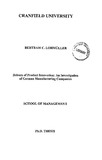JavaScript is disabled for your browser. Some features of this site may not work without it.
| dc.contributor.advisor | Goffin, Keith | |
| dc.contributor.author | Lohmühler, Bertram | |
| dc.date.accessioned | 2009-05-15T15:25:27Z | |
| dc.date.available | 2009-05-15T15:25:27Z | |
| dc.date.issued | 2003-09 | |
| dc.identifier.uri | http://hdl.handle.net/1826/3394 | |
| dc.description.abstract | Product innovation is an important driver for manufacturing companies to remain competitive. Although new products are essential to high-technology companies, other sectors are also focusing on product innovation. As the importance of product innovation becomes widely recognised, there is a need to analyse the relationship between product innovation rates and the percentage of revenues generated from new products (defined as product innovation position). Therefore, the purpose of this study is to determine why companies (business units) within the same industry sector (i. e., in the engineering and electrical & electronics engineering sector) operate with different product innovation positions. Much of the management literature is based on the assumption that product innovation leads to improved company performance in terms of competitive advantage, higher revenues with new products, higher market share and cost or quality advantages. Taking this argument into account, it might be expected that firms with high performance are innovating at a faster rate than less successful companies. But this relationship is not as clear as it appears. Overall, the reasons why companies innovate at different rates require investigation. In other words: the factors which influence product innovation positions need deeper examination. In order to identify the reasons for varying product innovation positions, the research was divided into three phases: The first phase was a survey of 81 business units, which collected data on the number of new products developed by companies. This phase identified errors in measuring the percentage of new products introduced in the last three years (product innovation rate). Therefore, in the second phase, the errors in measuring product innovation rate were corrected through a survey and telephone interviews. In this phase, data from 78 business units were analysed. In the third phase, further investigations focusing on the question why business units have different product innovation positions were conducted through case studies. The investigation used a model of Cooper and Kleinschmidt (1993) as a basis for the case study research of II business units in the industry sectors engineering and electrical & electronics engineering. The results identified three key drivers for product innovation positions: market, competition and product innovation strategy. Further, the two areas NPD management and corporate culture were found as key drivers for the management of product innovation processes. One further important finding is, that product innovation position do not show how innovative a business unit is. With regard to profits, the cross-case analysis found that independent from product innovation position only two of 11 business units earn more from new products than from the whole product portfolio (i. e., from both existing and new products). This implies that the product innovation rate and the percentage of revenues are related to the context. It has to be noted that an investigation of product innovation position was only possible by using a combination of both survey and case study approach. | en_UK |
| dc.language.iso | en | en_UK |
| dc.publisher | Cranfield University | en_UK |
| dc.title | Drivers of product innovation : an investigation of German manufacturing companies | en_UK |
| dc.type | Thesis or dissertation | en_UK |
| dc.type.qualificationlevel | Doctoral | en_UK |
| dc.type.qualificationname | PhD | en_UK |
